
Getting from Chubu Airport (Centrair) to Madarao Kogen
Map
Nagoya is Japan’s 4th largest city, with a population of over 2 million. Its main airport is Chubu International Airport, located offshore about 35 km south of downtown Nagoya.
There are several different routes for getting from Narita Airport to Madarao Kogen. If it is your first time to Madarao Kogen, or you have a lot of luggage, then you may be better off using a direct service like the Nagano Snow Shuttle.
Below we summarize the easiest route to Madarao Kogen from Chubu Airport by Public Transport. If you’d like advice on other routes, please do not hesitate to send us an inquiry.
Nagoya Airport
Nagoya’s Chubu Airport is one of the easiest airports to enter Japan. It is a modern airport, built offshore on reclaimed land.
The terminal has a smooth flow and connections to public transport.
The first leg of the trip is getting from Chubu Airport to Central Nagoya.
Meitetsu Railway
The line between Chubu Airport and central Nagoya is operated by Meitetsu Rail Co. This is one of the biggest transport operators in the central Japan area.
Chubu Kokusai Kuko Station
The name of the station at the airport is Chubu Kokusai Kuko Station (Chubu International Airport Station). It is located in the “Access Plaza” a short walk up a gentle slope from the arrival lobby on the 2nd floor.
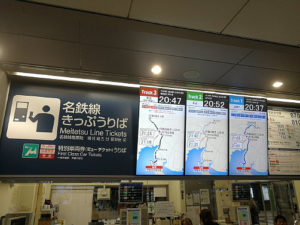
It is to the left of the information booth in the center of the plaza.
Buying Tickets
There are ticket counters and vending machines where you can buy tickets. Vending machines are multi lingual.
Because the first part of the trip is on the Meitetsu Line, you will need to buy a ticket here from Chubu Airport to Meitetsu Nagoya Station, and then buy the rest of your tickets once you arrive in central Nagoya.
Train Types
There are several different trains that run along the Meitetsu Airport Line. The base fare for this route is 890yen, but if you use the faster trains, there will be a 360yen surcharge bringing the total to 1,250yen per person.
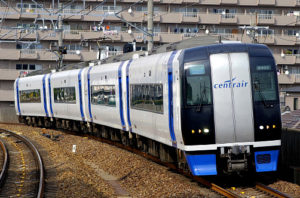
The signature train is the Myu-Sky express. According to the website, this train can cover the distance from Chubu to Nagoya in 28 minutes but in our experience it takes longer (generally 35-40 minutes).
There are also express commuter trains, and local trains. Avoid the local trains as they take forever, as they stop as every station.
The Trip
The trip is fairly uneventful as it is mostly through industrial areas and residential neighborhoods. There is a good view as you cross the airport access bridge, and also the skyscrapers around Nagoya Station.
Transfer to JR Nagoya Station
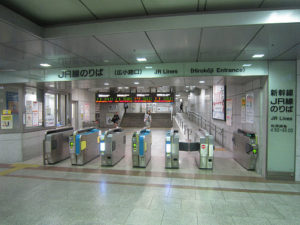
The transfer from Meitetsu Nagoya to JR Nagoya Station is not to difficult and is completely indoors.
On arrival Meitetsu Nagoya Station, take the escalator up from the platform to the ticket gate concourse. Go out the NORTH EXIT, and head to your left. There are plenty of signs guiding the way to JR Nagoya Station. The closest entrance is called the Hirokoji Entrance.
It takes about 5 minutes to walk, and it is best to allow at least 15 minutes to make your connection (more if you are not confident buying tickets in vending machines.
Buying a Ticket

JR Nagoya Station has 3 main entrances / exits. Sakuradori to the East, Taiko Dori Exit to the West, and Hirokoji Exit to the South-East. Most people will be using the Sakuradori Entrance, however if coming from Chubu Airport, then the Hirokoji Entrance is the closest.
There are ticket vending machines (multi-lingual) here as well as ticket counters.
The easiest option is to go to a ticket counter and talk to the person selling tickets. They will be able to give you the correct times.
Shinano Wide View Express
The train from Nagoya to Nagano (via Matsumoto) is called “Shinano Wide View Limited Express”. Limited Express are the 2nd fastest type of train in Japan after the Shinkansen Bullet train. They only stop at larger stations, and by-pass the commuter ones. The train from Nagoya to Nagano will only stop at about 10 stations along the way and take about 3 hours.
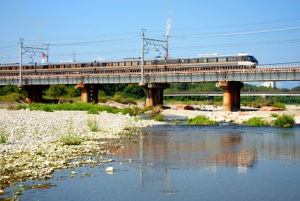
There are 6 carriages on the train. #1 is the front of the train heading towards Matsumoto, while 6 is the rear of the train.
Car 1 is Green Class (first class) and a surcharge is required in addition to the limited express fare.
Cars 2-4 are reserved sets. These are for people with seat assignments on their tickets.
Cars 5-6 are non-reserved, meaning these seats are on a first come basis.
There is no food or beverage service on this train so it pays to buy a few snacks at Nagoya Station before boarding.
Boarding the Train
Most of the Wide View Shinano Trains depart from platform #10, but you need to check the digital signs at the station entrance to confirm this as it can change on occasion.
The ticket sales and ticket gates are on the basement level. There are 3 pathways to the platforms (North, Central, and South). You walk along the tunnel like corridor and there are a number of staircases (and escalators on the North and Central pathways). These have the platform numbers on them. At the platform 10 sign, climb the stairs and you will be on the ground level on the platform.
There are small convenience stores on the platform where you can buy snacks and drinks.
The train will arrive 5-10 minutes before departure.
Nagoya to Nagano
The trip from Nagoya to Nagano takes about 3 hours. After leaving Nagoya the train travels through the suburbs before following a number of river valleys. Between the many tunnels, there are some great valley views on both sides of the train.
For much of the way the train follows the old Nakasendo route. This is the ancient walkway from Osaka to Tokyo through the mountains. Many of the townships you pass through on the way are the old staging towns where weary travelers would stay over night in small Japanese style lodges.
After Matsumoto the train runs through a number of tunnels and up to the Hijiri plateau. The final part of the trip offers great views of Nagano and Chikuma cities from Obasute.
Arrival at Nagano
There is no dedicated platform for Wide View Shinano arrivals at Nagano Station. But most trains arrive at either platform 2, 3 or 5.
Shinkansen Bullet train to Iiyama

Most of the Hakutaka Shinkansen Bullet trains coming up from Tokyo make a stop in Iiyama. There is only 1 train per hour on this route. It only takes 11 minute to get from Nagano Station to Iiyama Station.
On arrival at Nagano Station, you need to climb from the platform level to the concourse level and follow the Shinkansen Transfer signs. Trains to Iiyama will depart from platform 11 or 12.
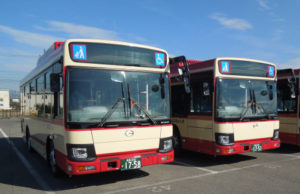
Bus to Madarao Kogen
There are several different bus lines operating between Iiyama Station and Madarao.
- Community Bus #1
This bus has 5-6 services per day between Iiyama station. This is the slowest bus as it stops many times. Cost is 500yen per adult - Express Bus #14
This is the fastest bus that runs to Madarao Kogen Hotel and Tangram also. There are only 2-3 buses a day. Cost is 700yen to Madarao Kogen Hotel, and 1,000yen to Tangram - Notoma Bus #22
This is the bus from Nozawa Onsen to Madarao Kogen that runs via Iiyama Station. This is mainly a bus for day trippers, so there is one bus in the morning, and one in the late afternoon. Fare is 700yen - Express Bus #25
This bus runs twice a day from Iiyama Station to Madarao Kogen Hotel. Cost is 700yen per person
Buying Tickets
There is a vending machine inside Iiyama Station right before you exit the building. Coming down the escalator, head to the furthermost exit door and you’ll see the vending machine in the corner. It only takes cash. If you don’t have cash then head to the Seven-Eleven close to the station (exit the station on the Chikumagawa Exit and turn right. Follow the train line south for 1 block and you see the seven-eleven). The Seven Eleven has an international ATM.
Boarding the Bus
The buses leave from bus stop #1.
Arrival in Madarao Kogen
All the buses stop at Yama-no-ie (Information Center), Plaza Mae, Madarao Kogen Hotel. Ask you accommodation which bus stop is closest. Only bus #14 goes as far as Tangram.
If your host has a pick up service, then call them when you leave Iiyama Station and let them know which bus you are on, and which bus stop you will be disembarking at.
